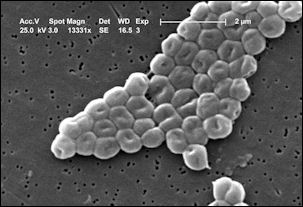BIOLOGICAL WEAPONS
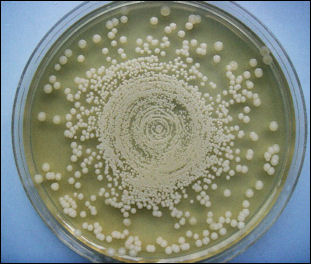
BpsMH Biological weapons are potentially more deadly than chemical weapons. A small amount can kill tens of thousands — perhaps even millions — of people but ultimately they are not suited for weapons because they are harder to preserve and deliver and act more slowly than chemical weapons. They are regarded as most effective on large populations of civilians rather than as a military weapon.
Because of the high casualty figures they can potentially produce and because they can be easy to make biological weapons are sometimes regarded as the poor man’s nuclear weapons. The agents are very powerful and concentrated: a small amount, which can be easily be smuggled from one country to another, can cause catastrophic death counts.
Among the biological weapons that are easy to deal with are botulism and salmonella. Using these terrorists could attack a water supply or food processing plant. Laboratories and equipment that make medicines and pesticides can easily be used or slightly altered to make biological weapon agents. For this reason it is difficult to find evidence of biological weapons production.
Steps to make a biological weapon: 1) Acquire the agents (perhaps from a commercial culture collection, hospital, soil of a contaminated area, former Soviet bioweapons scientist. 2) access information about bioweapons (much of it is available online in technical journals); 3) buy equipment (many devices are available from medical and laboratory supply companies); 4) culture and propagate the agent (much of this can be done with a basic knowledge of biochemistry and fermentation); and 5) weaponize the pathogen. [Source: Washington Post]
The last step is arguably the most difficult to over come. According to the Washington Post : it requires expertise in airborne materials, the milling of particles and isolation techniques to prevent handlers from getting sick. Also it is difficult t make agents that are both virulent and resistant to antibiotics.
Also See CHEMICAL WEAPONS AND TERRORISM factsanddetails.com ; CHEMICAL AND BIOLOGICAL WEAPONS IN RUSSIA factsanddetails.com; NUCLEAR AND BIOLOGICAL WEAPONS IN KAZAKHSTAN AND THEIR ENVIRONMENTAL AND HEALTH IMPACTS factsanddetails.com
Anthrax
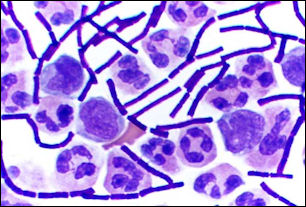
Anthrax Anthrax is a bacterial disease usually associated with farm animals. People rarely get it unless they have handled or eaten infected animals. Those who get it usually get cutaneous anthrax, which is caused when the bacteria is absorbed through cuts in the skin. Very few people get the pulmonary form which is caused by inhaling the bacteria's spores and considerably more deadly.
Anthrax is a soil-dwelling bacterium. The disease is picked up by inhaling microscopic amounts of spores. Early symptoms include malaise, vomiting and fever, and difficult to distinguish from other diseases. Anthrax is deadly in 90 percent of cases if not treated with antibiotics before the onset of symptoms. Suffocation can occur after four to seven days. Anthrax can be prevented with a vaccine. If large amounts of antibiotics are given to people before symptoms develop they usually can survive. But once symptoms set in a person usually dies within 36 hours.
Pulmonary anthrax has some unique features. Most pathogens need their hosts stay alive long enough for the disease to spread. Not anthrax. The bacteria quickly kills its host and then reverts to a spore and can remain in that state for decades. When inhaled the spores lodge in the lungs and produce lethal toxins as the bacteria germinates and reproduces.
Anthrax Biological Weapons

Biological weapons makers like spores from the pulmonary form of anthrax because they are extremely hardy and concentrated. A tiny amount can make many people sick, remain potentially dangerous for months, even years, and can be easily carried by the wind. Terrorists like anthrax because it is relatively easy to use but not contagions.
Biological weapons made with dried, ground anthrax spores are particularly dangerous because the spores are tough and concentrated and can survive even in a harsh environment for decades. Eight thousand spores, which can fit on a pin point, can be fatal. A vial full can kill or sicken many people, remain potentially dangerous for months or even years and be easily carried by the wind. If sprayed over a city the size of Omaha anthrax could kill up to 2.5 million and keep the city inhabitable for a long time.
Producing anthrax is relatively easy. All you need is an anthrax culture (available a few years ago for $45) and fermenter (a $50 model used by home beer brewers will do) to reproduce it. Making the dried form of spores is considerably more difficult. To make it requires expertise in airborne materials. Milling the particles and using isolation techniques to prevent handlers from getting sick are problematic.
Hundreds of tons of anthrax bacteria — enough to destroy all the people in the world several times over — was used in the development of biological weapons in the Soviet Union. Most of it was placed in stainless canisters and buried on Aral Sea's Vozrozhdeniye Island. The crowning achievement of the Soviet biological weapon’s program was Anthrax 836. Developed in 1987 and four times more deadly that its predecessor, it is “an extremely, fine grayish, brown powder that can drift invisibly for kilometers.”
Botulism and Small Box
Botulinum toxin is a severe form of the food poisoning toxin that causes botulism. Milligram for milligram, it is the deadliest substance known to science. It is 15,000 times more powerful than VX and 100,000 times stronger than sarin.
ricin vial Botulinum toxin acts more like a chemical weapon rather than a biological one because it knocks out the respiratory system as opposed to causing an infection. It blocks nerve transmissions and can enter the system orally or through inhalation. It causes death through suffocation by paralyzing the lungs and can cause respiratory failure in two to 12 hours. . . If dropped on a large shopping mall it could kill up to 40,000 people.
The effects depend on the dose. Ventilators can often keep a victim alive until the paralysis passes. Recovery though can take months. An antidote made from horse serum can prevent the illness if administered early.
Small pox is perhaps the scariest agent for a biological weapons because it is the deadliest of all contagious human agents: once it spreads and people get infected they could spread to other people and they pass it on to other people and so on. The “hottest” strains kill as many as 50 percent of the people they infected. Some scenarios of a small pox attack have millions dead.
Smallpox can easily be sprayed into a crowded place. Victims wouldn’t begin to display symptoms until 10 to 14 days after the attack. People who came in contact with them who have a good chance of contacting the disease. In the event of a terrorist attack, the disease could quickly overwhelm the health care system.
One of the greatest concerns is a terroris creating a bioweapon with a smallpox chimera”part virus, part human DNA. A smallpox chimera could potentially be more deadly and contagious than the original and be immune to vaccinations that eradicated the disease. Advances in molecular biology and genetic engineering have made such of microbe possible but doubts remain as to whether a smallpox chimera could be as deadly as smallpox.
Other Biological Agents
Ricin is an agent made from castor-bean plants, which is also used to make laxatives. It can be ingested, inhaled or injected. If ingested it can cause severe and rapid bleeding of the stomach and intestines. If it gets into the blood it can cause severe damage to the liver, kidneys and spleen and a slow death through circulatory collapse. It has no antidote. Ricin can be administered as a pellet, mist or powder and be dissolved in liquid.
According to the United Nations, Iraq admitted to making 2,200 liters aflatoxin, an agent that causes liver cancer; 340 liters of clostridium perfringens, a gaseous form of gangrene that causes the flesh to rot; and 10 liters of ricin. The Iraqis also reportedly experimented with hemorrhagic conjunctivitis, an agent that causes eyeballs to bleed and produces temporary blindness; camel pox, a pustular disease that is thought to be deadly to foreigners and harmless to Iraqis; wheat smut, which ruins food crops; tricothescene mycotoxins, which cause nausea, vomiting and diarrhea; rotavirus, which causes acute diarrhea and can lead to death; and yellow rain..
Biological weapons that have been experimented with in other places include plague, tularemia. Q fevers, and ricin.
Early Biological Weapons
In the 6th century B.C. Assyrians poisoned wells of enemies with the rye ergot fungus, which induced a diseases called ergotism. Symptoms included convulsions and gangrene, leading to death. [Source: Washington Post ]
In 1347, Tartars besieging Kaffa on the Black Sea catapulted corpses of plague victims into the city, where Genoese colonists gathered. Many city dwellers died. Some of the survivors escaped on ships returning to Genoa, carrying the plague with them.
In 1761, in the French and Indian War in colonial America, British soldiers under siege in Fort Pitt by Indian tribes, allied with France, gave the Indians blankets ostensibly as a friendly gesture. The blankets were infected with smallpox, and thousands of Indians died.
Germ Experiments at Unit 731
Prisoners at Unit 731 — a notorious camp run by the Japanese near Harbin, China in World War II — were and infected with the bubonic plague, syphilis, cholera, typhoid, anthrax and a variety of other viruses, bacteria and diseases. An estimated 10,000 prisoners died from these experiments.
Similar experiments were conducted at Unit 8604 at Zhongshan University near Canton where perhaps 20,000 people, previously thought to have died from starvation, may have actually died from infections diseases planted on them by scientists. Few details are known, but bodies buried in earthen jars have been discovered and local residents say they saw large numbers of bodies dumped in pits and destroyed in vats of chemicals.
As many as 250,000 people died in field tests of germ agents and biological weapons produced at Unit 731 and other laboratories in at least a dozen cities, including Beijing, Dalien and Nanjing. More than 300 people died when cholera germs were sprayed on Beijing. People also died from ingesting food purposely infected with cholera.
Plague Bombs in China
Various experiments were conducted with fleas, rats and the plague. In one experiment plague-carrying fleas were raised in a bathtub and then mixed with wheat to attract disease-carrying rats. These rats were air dropped over China’s eastern province of Zhejiang and central Hunan province from 1940 to 1942. People who lived in these areas described how people dropped like flies in hours or days, their bodies swollen and black. Those who came for the funerals spread the disease when they returned home. The Chinese government claims that 270,000 were killed but there is little evidence to support the claim that so many were killed.
In another experiment plague-carrying fleas were raised on the bodies of rats in special incubators that could produce about 40 pounds of infected fleas a month. One man working on the plague project told U.S. News and World Report, "We would inject the most powerful bacteria into the rats. On a 500-gram rat we would attach 3,000 fleas. When the rats were released, the fleas would transmit the disease."
The plague was also dispensed via air drops and placed into the drinking water at the end of the war, killing thousands of local Chinese. The scientists also worked on developing balloons that could carry disease agents to the United States.
There were plans to place plague-carrying rats into plane-released porcelains bombs that kept the creatures alive until were released in the air and floated to the ground on parachutes. The surrender on August 1945 scuttled a plan for kamikaze pilots to attack San Diego in planes filled with plague-infected fleas.
Soviet Anthrax Accident
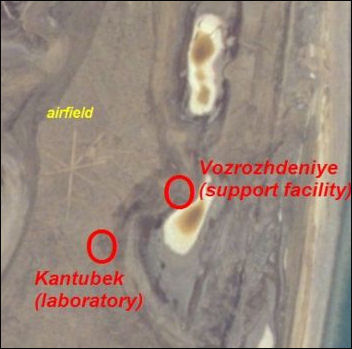
Vozrozhdeniye Island In April 1979, at least 64 people died in an unprecedented anthrax epidemic in Sverdlovsk, a southern Ural city of 1.2 million, caused by the accidental release of about one gram of anthrax spores from a military facility known as Compound 19. It is the deadliest anthrax outbreak on record.
No mention of the disaster appeared in the newspapers or on television. No effort was made to warn, help or inform the people of Sverdlovsk as to what happened. Downwind from the facility, roofs were hosed down, streets were disinfected by workers and some people were given shots of an antibiotic. Families were told that the victims had died of pneumonia or influenza.
It is believed the anthrax escaped after a clogged filter had removed before a shift change and was replaced in the next shift. Hours passed before the mistake was realized. By that time anthrax spores had been released into the air and carried by the wind.
Local health authorities were told nothing except to be on the alert for an infectious disease. They realized something was not right when patients showed up with the soft tissues of their brains permeated with blood. Spores carried by the wind killed farm animals 30 miles away. At least one human victims worked a ceramic factory two miles from the facility. One survivor who came down with anthrax told the Los Angeles Times doctors showed up with needles and pills. "We were not told it was anthrax,” he said. "Doctors told me I must have gotten an infection from meat...Doctors also prescribed tetracycline to all of us as a precaution and then told us to swallow these pills by the pack: three times a day, six pills at a time."
The families of victims were told their loved ones died from sepsis or “bad meat.” They figured something was amiss when men that came to check the victims wore protective suits. One victim, a 27-year-old man, collapsed on the street a few blocks form Compound 19. His mother told National Geographic, “They wrote “sepsis” on the death certificate. Then we heard rumors that it had been anthrax. My husband and I were terribly afraid. Our son had spent the night before he died at home with us. The people in the morgue refused to dress the body, so we did it ourselves. To this day, no one ever told us that anthrax killed him. They gave us 40 rubles, and I used it to buy a dress for the funeral.”
The outbreak could have been much worse if the wind was blowing in a different direction. For some unexplained reason no children died although many were outside playing at the time the anthrax was in the air.
Biological Weapons Testing at Vozrozhdeniye Island

Vozrozhdeniye Island A top-secret facility on Vozrozhdeniye Island in the Aral Sea was the world’s largest biological weapons testing ground and was one of the primary testing grounds for Russia's biological weapons using anthrax and other diseases. The island contained pens that held thousands of animals — rabbits, guinea pigs, monkeys, sheep, donkeys, mice, hamsters, horses and baboons — that were used in testing. Around 1,500 people lived on the island at its height. [Source: Christopher Pala, New York Times Magazine, January 12, 2002.
Gennadi Lepyoshkin, a scientist who worked at Vozrozhdeniye told the New York Times, “About one-third of our work was on weapons, like anthrax, plague and other bacteria, and two thirds on matters like testing vaccines or clothing or how long microorganisms would survive in the soil....The atmosphere was friendly, people were earning good money and we were provided with everything.” The workers used to sunbath, dance and hunt ducks in their free time.
Much the testing involved giving disease-causing agents to animals. Lepyoshkin told the New York Times, “We used monkeys, about 200 to 300 each year. Our staff would take them out to the range—“25 kilometers from the town” — and they would put them in cages next to devises that the measured the concentration of germs in the air. Then after they were exposed, they would be taken to the labs, where we would test their blood and monitor the development of a disease in them. They would die within weeks, and we would perform autopsies..” The testing was usually only done in the summer when temperatures soared to 120̊F to prevent the spread of the pathogens,
Lepyoshkin said, “There was always danger, but we never had an accidents. He recalled on incident in which a woman dropped a petri dish containing anthrax. She tried to hide her mistake but her accident was discovered. Her punishment: she was docked some money on her paycheck. “No one got sick,” Lepyoshkin said.
Aum Shinrokyo and Chemical and Biological Weapons
A medical team from Shinrokyo was sent to Zaire to investigate the outbreak of the Ebola virus that occurred there, obtain samples of the virus, and investigate the possibility of using the virus in biological weapons. Aum members had also looked into using smallpox and yellow fever in bio-weapons. It tried to synthesize green mamba venom, and made efforts to cultivate the anthrax and botulism virus.
In April 1990, cult members sprayed botulism germs (the strongest known toxins against humans) from three trucks that drove through the streets of greater Tokyo. No one got sick because the germs dispersed and quickly died. The members then switched their attention to anthrax because it remains potentially dangerous for a much longer time.
John Mintz wrote in the Washington Post: “Hoping to hasten the doomsday their leader foretold, scientists who were members of Japan's Aum Shinrikyo cult brewed batches of anthrax in the early 1990s and released it from an office building and out the back of trucks upwind of the Imperial Palace. But the wet mixture kept clogging the sprayers the Aum Shinrikyo scientists had rigged up, and, unbeknown to them, the strains of anthrax they had ordered from a commercial firm posed no danger to anyone. Frustrated by their failure at biowarfare, they turned to a less arduous method of mass killing “chemical attack — and in 1995 killed 12 Tokyo subway riders by releasing sarin gas in the tunnels. The cult's experiences demonstrate just a few of the myriad technical obstacles that terrorists who might try to manufacture biological weapons could face, problems that would confound even skilled scientists who tried to help them, biological warfare experts say. [Source: John Mintz, Washington Post, December 30, 2004]
2001 U.S. Anthrax Attacks
The 2001 anthrax attacks in the United States, also known as Amerithrax from its Federal Bureau of Investigation (FBI) case name, occurred over the course of several weeks beginning on Tuesday, September 18, 2001, one week after the September 11 attacks. Letters containing anthrax spores were mailed to several news media offices and two Democratic U.S. Senators, killing five people and infecting 17 others. According to the FBI, the ensuing investigation became "one of the largest and most complex in the history of law enforcement". [Source: Wikipedia]
The anthrax attacks came in two waves. The first set of anthrax letters had a Trenton, New Jersey postmark dated September 18, 2001. Five letters are believed to have been mailed at this time to: ABC News, CBS News, NBC News and the New York Post, all located in New York City and to the National Enquirer at American Media, Inc. (AMI) in Boca Raton, Florida. Robert
Stevens, the first person who died from the mailings, worked at a tabloid called Sun, also published by AMI, died on October 6, 2001, four days after entering a Florida hospital with an undiagnosed illness that caused him to vomit and be short of breath. Only the New York Post and NBC News letters were found; the existence of the other three letters is inferred because individuals at ABC, CBS and AMI became infected with anthrax. Scientists examining the anthrax from the New York Post letter said it appeared as a coarse brown granular material looking like Purina Dog Chow.
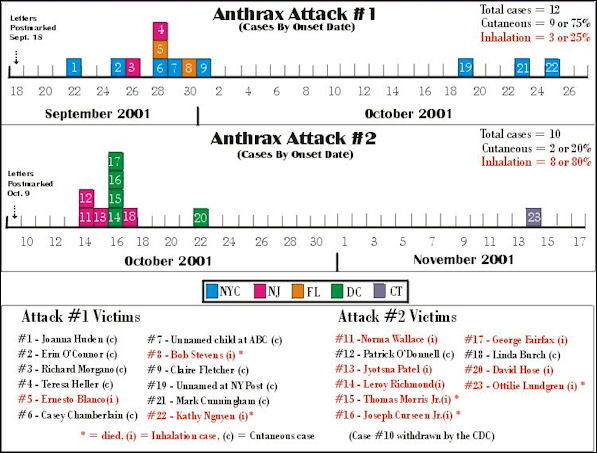
Two more anthrax letters, bearing the same Trenton postmark, were dated October 9, three weeks after the first mailing. The letters were addressed to two Democratic Senators, Tom Daschle of South Dakota and Patrick Leahy of Vermont. At the time, Daschle was the Senate Majority leader and Leahy was head of the Senate Judiciary Committee. The Daschle letter was opened by an aide, Grant Leslie, on October 15, and the government mail service was shut down. The unopened Leahy letter was discovered in an impounded mail bag on November 16. The Leahy letter had been misdirected to the State Department mail annex in Sterling, Virginia, due to a misread ZIP code; a postal worker there, David Hose, contracted inhalational anthrax.
More potent than the first anthrax letters, the material in the Senate letters was a highly refined dry powder consisting of about one gram of nearly pure spores. USAMRIID scientists' lack of familiarity with powdered anthrax resulted in initial reports that the powders had been "weaponized" with silica. Bioweapons experts who later viewed images of the attack anthrax saw no indication of "weaponization". Tests by Sandia National Laboratories in early 2002 confirmed that the attack powders were not weaponized.
At least 22 people developed anthrax infections, with 11 of the especially life-threatening inhalational variety. Five died of inhalational anthrax: Stevens; two employees of the Brentwood mail facility in Washington, D.C., Thomas Morris Jr. and Joseph Curseen; and two whose source of exposure to the bacteria is still unknown: Kathy Nguyen, a Vietnamese immigrant resident in the borough of the Bronx who worked in New York City, and Ottilie Lundgren, a 94-year old widow of a prominent judge from Oxford, Connecticut, who was the last known victim.
A major focus in the early years of the investigation was a bio-weapons expert named Steven Hatfill, who was eventually exonerated. Another suspect, Bruce Edwards Ivins, became a focus of investigation around April 4, 2005. Ivins was a scientist who worked at the government's biodefense labs at Fort Detrick in Frederick, Maryland. On April 11, 2007, Ivins was put under periodic surveillance and an FBI document stated that "Bruce Edwards Ivins is an extremely sensitive suspect in the 2001 anthrax attacks". On July 27, 2008, Ivins killed himself with an overdose of acetaminophen. On August 6, 2008, despite having no direct evidence of his involvement, federal prosecutors declared Ivins to be the sole culprit of the crime. On February 19, 2010, the FBI formally closed its investigation.
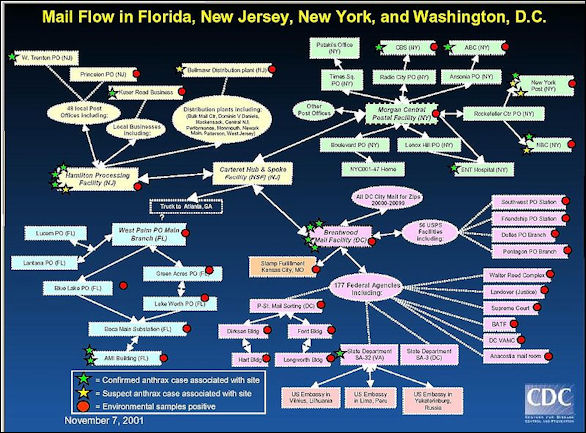
Anthrax mail flow chart
Obstacles to Creating Biological Weapons
Terrorists have to overcome a number of obstacles to create biological weapons. John Mintz wrote in the Washington Post: “Locating virulent anthrax specimens with which to brew an attack-size batch would be difficult given the medical community's caution about suspicious buyers. Smallpox could be next to impossible to obtain because it is thought to exist in only two secure sites, in Russia and in the United States. Creating aerosolized microbes also requires expertise in many arcane scientific disciplines, such as culturing and propagating germs that retain their virulence and "weaponizing" them so they float like a gas and enter the lungs easily.
“Those skeptical of the prospect of large-scale bioattacks cite the tiny number of biological strikes in recent decades. Members of the Rajneeshee cult sickened 750 people in 1984 when they contaminated salad bars in 10 Oregon restaurants with salmonella. Among the few others were the 2001 anthrax attacks through the U.S. mail that killed five people. One reason for the small number of attacks is that nearly every aspect of a bioterrorist's job is difficult. The best chance of acquiring the anthrax bacterium, Bacillus anthracis, is either from commercial culture collections in countries with lax security controls, or by digging in soil where livestock recently died of the disease — a tactic Aum Shinrikyo tried unsuccessfully in the Australian Outback.
“Once virulent stocks of anthrax have been cultured, it is no trivial task to propagate pathogens with the required attributes for an aerosolized weapon: the hardiness to survive in an enclosed container and upon release into the atmosphere, the ability to lodge in the lungs, and the toxicity to kill. The particles' size is crucial: If they are too big, they fall to the ground, and if they are too small, they are exhaled from the body. If they are improperly made, static electricity can cause them to clump.
“Making a bug that defeats antibiotics, a desired goal for any bioweaponeer, is relatively simple but can require laborious trial and error, because conferring antibiotic resistance often reduces a bioweapon's killing power. Field-testing germ weapons is necessary even for experienced weapons makers, and that is likely to require open spaces where animals or even people can be experimentally infected.
“Each bioagent demands specific weather conditions and requires unforgiving specifications for the spraying device employed. "Dry" anthrax is harder to make -- it requires special equipment, and scientists must perform the dangerous job of milling particles to the right size. "Wet" anthrax is easier to produce but not as easily dispersed.

2001 Anthrax targets
Increasing Likelihood of Creating Biological Weapons
John Mintz wrote in the Washington Post: But specialists also say it is all but inevitable that al Qaeda or another terrorist group will gain the expertise to launch small-scale biological attacks and eventually inflict mass casualties. Information on the mechanics of creating bioweapons is easily accessible on the Internet and in technical manuals, and the equipment to do the job is readily found. Many brew pubs, for example, have fermenters that can cook up deadly germs. [Source: John Mintz, Washington Post, December 30, 2004]
“Advances in bioscience, and the rapid dissemination of this knowledge worldwide, are making it easier for even undergraduates to create dangerous pathogens. Creating microbe weapons is more challenging than producing the simplest implements of terrorism — conventional explosives or chemical weapons — but much less difficult than the most technically daunting — nuclear weapons — experts say.
“Richard Danzig, a former Navy secretary and now a biowarfare consultant to the Pentagon, said that while there are 1,000 to 10,000 "weaponeers" worldwide with experience working on biological arms, there are more than 1 million and perhaps many millions of "broadly skilled" scientists who, while lacking training in that narrow field, could construct bioweapons. "It seems likely that, over a period between a few months and a few years, broadly skilled individuals equipped with modest laboratory equipment can develop biological weapons," Danzig said. "Only a thin wall of terrorist ignorance and inexperience now protects us."
“Some agents are simpler than others to weaponize. Toxins such as botulinum, which is not contagious and unlikely to cause mass casualties, are the easiest to turn into weapons, particularly for a food-borne or water-borne attack. Bacterial agents such as anthrax, which also is not contagious, are more difficult to manufacture. Viruses such as smallpox, which is contagious and could kill millions, are tougher still.
“The most challenging are some of the new 21st-century bioweapons that scientists contemplate being created in the future -- but experts believe even these compounds are fast becoming easier to produce.In 2002, a panel of biowarfare experts concluded in a report co-published by the National Defense University (NDU) that while terrorists could mount some small-scale bioattacks, larger assaults would require them to overcome many technical hurdles. Some key biotechnologies would be achievable only three to four years from then, the panel found. "When we sent out the report for review to [hands-on] bench scientists, we got the response, 'What do you mean we can't do this? We're doing it now,' " said Raymond Zilinskas, a co-author of the report who heads biowarfare studies at the Center for Nonproliferation Studies, a California think tank. "It shows how fast the field is moving."
Worst Case Biological Weapons Scenarios

1993 48 Kameido
isolates genotype John Mintz wrote in the Washington Post: Experts agree that anthrax is the potential mass-casualty agent most accessible to terrorists. The anthrax letter sent in 2001 to then-Senate Minority Leader Thomas A. Daschle (D-S.D.) contained one gram of anthrax, or 1 trillion spores.
In a 2003 report for the Pentagon, Danzig estimated that if terrorists released a much larger amount of skillfully made anthrax particles under optimal weather conditions in a large city, 200,000 people in an area 40 miles downwind of the release would be infected, and, if untreated, 180,000 of them would die. Smaller numbers would die as far as 120 miles away. [Source: John Mintz, Washington Post, December 30, 2004]
“Government officials would probably realize that an attack had occurred a day or two later, when victims began to show up in emergency rooms with flulike symptoms. Guessing the geographical spread of the attack, officials would then order emergency distribution of ciprofloxacin or other antibiotics, which would probably save many lives -- although experts agree the public health response would be likely to be chaotic and possibly ineffective.
“For most experts, the most frightening anthrax scenario is an antibiotic-resistant bug, which many say is not far-fetched. It is "one of the big things we're worried about," Philip K. Russell, a top bioterrorism adviser in the Department of Health and Human Services, said in an August interview in the trade journal Biosecurity. "It's my view that we have about three or four years to come up with a solution to multidrug-resistant anthrax. . . . We haven't taken anthrax off the table as a threat that can create a very big disaster."
“Government officials also said they accept a Danzig theory that terrorists probably would launch bioattacks against various cities simultaneously or sequentially, using a tactic he calls "reload." Danzig said it would be designed to overwhelm government responses and undermine public confidence in officials. "Our national power to manage the consequences of repeated biological attacks could be exhausted while the terrorist ability to reload remains intact," he wrote in the Pentagon report.
“The 2002 NDU study -- led by Zilinskas and Seth Carus, a biowarfare expert at the university -- concluded that at that time, large-scale bioweapons were less likely to be fashioned by terrorists than by nations such as Iran, or by disgruntled bioscientists. The report also detailed the skill levels necessary to accomplish various biowarfare-related tasks. A "junior scientist," for example, could use genetic engineering to weaponize both bacterial and viral pathogens. Experts say that since then, the spread of knowledge and the increasing availability of sophisticated equipment have placed more and more complex tasks within the ability of less-skilled people. Some experts expressed concern about the easy availability of inexpensive biological "kits" from commercial catalogues that streamline cloning and other once-daunting tasks.
Superbugs and Designer, Custom-Built Biological Weapons

Kameido site fluid petri Joby Warrick wrote in the Washington Post: In 2011, the “deadly anthrax attacks forced Americans to confront the suddenly real prospect of bioterrorism. Since then the Bush administration has poured billions of dollars into building a defensive wall of drugs, vaccines and special sensors that can detect dangerous pathogens. But already, technology is hurtling past it. While government scientists press their search for new drugs for old foes such as classic anthrax, a revolution in biology has ushered in an age of engineered microbes and novel ways to make them. [Source: Joby Warrick, Washington Post, July 31, 2006]
“Eckard Wimmer knows of a shortcut terrorists could someday use to get their hands on the lethal viruses that cause Ebola and smallpox. He knows it exceptionally well, because he discovered it himself. In 2002, the German-born molecular geneticist startled the scientific world by creating the first live, fully artificial virus in the lab. It was a variation of the bug that causes polio, yet different from any virus known to nature. And Wimmer built it from scratch.
“The virus was made wholly from nonliving parts, using equipment and chemicals on hand in Wimmer's small laboratory at the State University of New York here on Long Island. The most crucial part, the genetic code, was picked up for free on the Internet. Hundreds of tiny bits of viral DNA were purchased online, with final assembly in the lab. Wimmer intended to sound a warning, to show that science had crossed a threshold into an era in which genetically altered and made-from-scratch germ weapons were feasible. But in the four years since, other scientists have made advances faster than Wimmer imagined possible. Government officials, and scientists such as Wimmer, are only beginning to grasp the implications.
Acinetobacter baumannii John Mintz wrote in the Washington Post: The Zilinskas-Carus report said it is "chancy" to estimate which weapons terrorists could make...because of scientists' increasing ability to synthesize and manipulate biological material such as DNA. "Novel DNA sequences are being designed and inserted into living cells by undergraduates," said Roger Brent, a biowarfare expert who is president of the Molecular Sciences Institute, a leading research group in Berkeley, Calif. [Source: John Mintz, Washington Post, December 30, 2004]
Some scientists doubt terrorists will master genetically altered superbugs. But Brent and other experts raise the specter of terrorists' hiring scientists who can insert a toxin into, say, a bioengineered SARS virus, which would then be as contagious as severe acute respiratory syndrome and as fatal as the toxin inside it.Last year, Brent told a study panel convened by the CIA that current biological capability resembles the capacity of computers in 1965, or English cotton mills in the 1800s -- technologies on the cusp of explosive growth. He said the day is coming when not only terrorists but "garage hackers" will be able to assemble bioweapons.
The CIA panel's late 2003 report, "The Darker Bioweapons Future," said that "the same science that may cure some of our worst diseases could be used to create the world's most frightening weapons. The know-how to develop some of these weapons already exists."
Even banned viruses such as smallpox might be employed one day by terrorists who sidestep the difficulty of obtaining them by synthesizing agents that resemble them, Brent told the panel. "Once synthesized," he said, they "can be grown in indefinite quantities.""The Rubicon has already been crossed and the process of creating novel genetically engineered orthopoxviruses [diseases including smallpox] is irrevocable," Ken Alibek, a former Soviet bioscientist who defected to the United States, wrote recently in a scholarly journal. "It is just a matter of time before this knowledge will result in the creation of super-killer poxviruses." He added: "If a threat, no matter how small, of a smallpox attack exists, it must be addressed" by developing smallpox detection systems and medicines. "The alternative," Alibek wrote, "is to remain as helpless as the millions of people who died of smallpox over previous centuries."
Secretive Fight Against Bioterror

ricin letter metal vial The Bush administration established a secret laboratory — the National Biodefense Analysis and Countermeasures Center (NBACC) — at Fort Detrick, Maryland to study bioweapons in violation of international treaties. Joby Warrick wrote in the Washington Post: “Created without public fanfare a few months after the 2001 anthrax attacks, NBACC is intended to be the chief U.S. biological research institution engaged in something called "science-based threat assessment." It seeks to quantitatively answer one of the most difficult questions in biodefense: What's the worst that can happen?To truly answer that question, there is little choice, current and former NBACC officials say: Researchers have to make real biological weapons. "De facto, we are going to make biowarfare pathogens at NBACC in order to study them," said Penrose "Parney" Albright, former Homeland Security assistant secretary for science and technology. [Source: Joby Warrick, Washington Post, July 30, 2006]
“Other government agencies, such as the Centers for Disease Control and Prevention, study disease threats such as smallpox to discover cures. By contrast, NBACC (pronounced EN-back) attempts to get inside the head of a bioterrorist. It considers the wide array of potential weapons available. It looks for the holes in society's defenses where an attacker might achieve the maximum harm. It explores the risks posed by emerging technologies, such as new DNA synthesizing techniques that allow the creation of genetically altered or man-made viruses. And it tries in some cases to test the weapon or delivery device that terrorists might use.
Research at NBACC is already underway, in lab space that has been outsourced or borrowed from the Army's sprawling biodefense campus at Fort Detrick in Frederick. It was at this compound that the U.S. government researched and produced offensive biological weapons from the 1940s until President Richard M. Nixon halted research in 1969. The Army continues to conduct research on pathogens there.
In June, construction began on a $128 million, 160,000-square-foot facility inside the same heavily guarded compound. Space inside the eight-story, glass-and-brick structure will be divided between NBACC's two major divisions: a forensic testing center tasked with using modern sleuthing techniques to identify the possible culprits in future biological attacks; and the Biothreat Characterization Center, or BTCC, which seeks to predict what such attacks will look like.
Image Sources: Wikimedia Commons
Text Sources: New York Times, Washington Post, Los Angeles Times, Times of London, The Guardian, National Geographic, The New Yorker, Time, Newsweek, Reuters, AP, AFP, Wall Street Journal, The Atlantic Monthly, The Economist, Global Viewpoint (Christian Science Monitor), Foreign Policy, Wikipedia, BBC, CNN, NBC News, Fox News and various books and other publications.
Last updated July 2012


